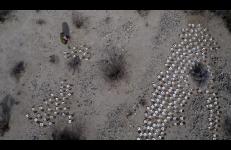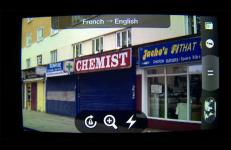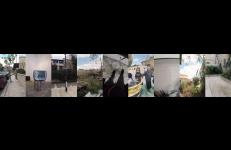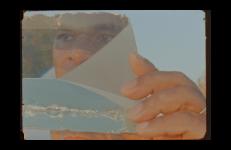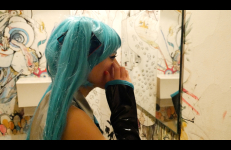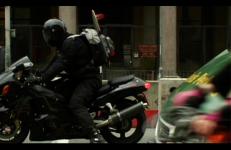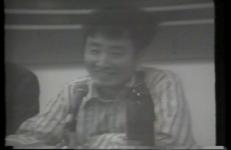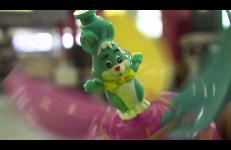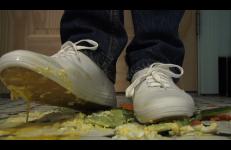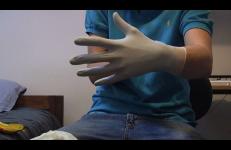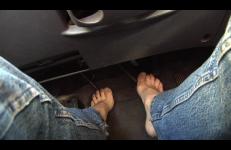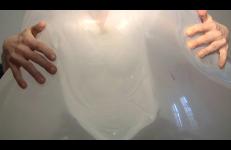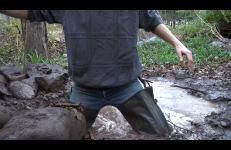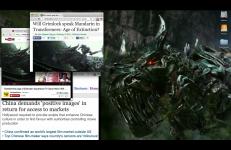The Sky Is Falling... is part of an ongoing series of performances that make up The Data Humanization Project.
Technology
Slip is from Martine Syms’ Kita’s World series. Kita enacts the performances of everyday life in a hyper-digitized world. The character’s roles range from meditation guru to cultural commentator, and she speaks directly to questions of consciousness within the systems of labor, race, technology, and institutional failure. To the cognitive dissonance of Siri mishearing her speech, to the terror of (mis)representation, to the instinct to reconnect with nature.
Soliloquy is from Martine Syms’ Kita’s World series. In the series, Kita enacts the performances of everyday life in a hyper-digitized world. The character’s roles range from meditation guru to cultural commentator, elaborating on questions of race, gender, and technology prevalent throughout the artist’s practice. In these video works, Syms creates an environment in which being human is inextricably linked to the impact and interruptions of technological innovation.
Prompted by Apple’s Siri to ask questions, Magenheimer takes the AI invitation seriously and invents a long list of queries. We see them appear one by one over scanned images from Architectural Digest magazine’s idealized interiors of 1981, the year Magenheimer was born and the year Ronald Reagan became president.
The sale of a plot of land marks the kickoff of an unlikely road trip in this strange American odyssey. When eteam buys an acre of the Southwestern desert on eBay, the deed fails to arrive and the pair attempt to track down the phantom seller. Children in tow, the artists embark on a noir-inspired search through Colorado, Arizona and the American West to locate the shadowy landowner and claim their portion of the vast desert.
Filmed directly from the screen of a smartphone using a language translator app that has been told to translate from French into English, Steve Hates Fish interprets the signage and architecture in a busy London shopping street. In an environment overloaded with information, the signs run riot as the confused and restless software does its best to fulfill its task.
Strip / Musrara is part of Assor's ongoing “Strip” series, set in Jerusalem’s Musrara neighborhood. It is an attempt to create a living map that is both collective and subjective – a plurality of combined perspectives. Not a map of the exact measurements of the neighborhood, but of the experience of moving through it, together and alone, locals and strangers, intersecting and drifting apart.
Animation by Dan Sandin
Algorithms by John Hart and Yumei Dang
Programming by Dan Sandin and Shalini Venkataraman
Visionary Leadership by Tom DeFanti
Mathematical leadership by Louis Kauffman
Music Composition and Performance by Stephan Vankov
Produced at the Electronic Visualization Laboratory, UIC, and Calit2, UCSD
Sunstone tracks Fresnel lenses from their site of production to their exhibition in a museum of lighthouses and navigational devices. It also examines the diverse social contexts in which optics are implicated, contrasting the system of triangular trade that followed the first European arrivals in the ‘New World’ with the political potential seen in Op art in post-revolutionary Cuba.
Sunstone tracks Fresnel lenses from their site of production to their exhibition in a museum of lighthouses and navigational devices. It also examines the diverse social contexts in which optics are implicated, contrasting the system of triangular trade that followed the first European arrivals in the ‘New World’ with the political potential seen in Op art in post-revolutionary Cuba.
Shot in a creaky, wooden floored Parisian recording studio at an inaugural three-day “forum of ideas” focusing on the manifold possibilities of Resistance (the title of Jean-François Lyotard’s unrealized follow-up exhibition to his 1983 Les Immateriaux), occasional collaborators Ben Rivers and Ben Russell have produced what initially appears to be a structuralist document of a philosophical discussion in-the-round. This “appearance dimension” is deceptive, of course, and with the aid of an immersive 5.1 sound-mix, a Green Man, a Green-Man-shaped
Shot in a creaky, wooden floored Parisian recording studio at an inaugural three-day “forum of ideas” focusing on the manifold possibilities of Resistance (the title of Jean-François Lyotard’s unrealized follow-up exhibition to his 1983 Les Immateriaux), occasional collaborators Ben Rivers and Ben Russell have produced what initially appears to be a structuralist document of a philosophical discussion in-the-round. This “appearance dimension” is deceptive, of course, and with the aid of an immersive 5.1 sound-mix, a Green Man, a Green-Man-shaped
Hatsune Miku is a co-creation platform, personified by a cute and oddly seductive animated character. Fans bring her to life by creating content that she “delivers”. Her entire persona: lyrics, music and animation – is fan created, and that's her charm. Cosplaying Hatsune Miku, Ann Oren goes to Tokyo for a performative journey among these fans and explores the Miku phenomenon as an expression of collective fantasy. The habits of Miku's fans is a familiar exaggeration of our social media habits, that flood us with crowd creativity.
It is TIME at a street corner in London... A collaboration between filmmaker Roderick Coover and writer Deb Unferth, this short marks the textual disintegration of the speaking clock in an unnerving portrait of technology, power, and the urban environment.
Shot in Lebanon, Syria and Jordan, this essay uses transportation, video, and photography to examine images circulating in a historically charged, and presently war-torn and divided, Middle East. From images of camels in the desert to images of the Arab-Israeli conflict, the video looks at states of mind in relation to actual geographies. The video pays tribute to an unformatted and open-ended documentary approach, and examines modes of access to information such as travel, television and the Internet, while carefully displaying the resulting iconography.
This Is A Studio uses surveillance footage that captures a late-night police visit. This document raises questions about home, belonging, and systems of power.
This tape was produced by Artists TV Network, documenting a symposium that included composer John Cage, choreographer Merce Cunningham, writer Richard Kostelanetz, and video artist Nam June Paik with art critic Dore Ashton serving as moderator. This freewheeling symposium taped before a live audience ranges from individual reminiscences to discussion of then-current art community concerns about music, literature, theater, art, dance, video, and technology.
An intense conversation between two people one evening leads to a pictorial love story about loss and longing. An homage to Eric Rohmer and the attention he paid to the tiny details of everyday life. An eternal story of love and separation.
Too Many Things visits the world of objects — their accumulation and dispersal — and their creation of cummunities of curiosity. The title is somewhat ironic. My work has always fed on things as the symbolic and incidental expressions of human presence. For a photographer, or a filmmaker, there can never be too many things; the camera likes to ferret them out and hang onto them, just as some people do. "Piled-up structures of inference and implication," as Clifford Geertz described ethnography's places of study, have also been my sites of activity as an arti
The first video of the installation Touch Parade, which as a whole explores “plastic love” or fetish culture and the assimilation of marginalized sexuality on the internet. In questioning what is an explicit and/or illicit image, fetishes found on YouTube that consist of banal gestures, are re-performed. Unlike other pornographic content, these videos evade censoring because they are not culturally recognized as representations of sexuality.
The fourth video of the installation Touch Parade, which as a whole explores “plastic love” or fetish culture and the assimilation of marginalized sexuality on the internet. In questioning what is an explicit and/or illicit image, fetishes found on YouTube that consist of banal gestures, are re-performed. Unlike other pornographic content, these videos evade censoring because they are not culturally recognized as representations of sexuality.
The fifth video of the installation Touch Parade, which as a whole explores “plastic love” or fetish culture and the assimilation of marginalized sexuality on the internet. In questioning what is an explicit and/or illicit image, fetishes found on YouTube that consist of banal gestures, are re-performed. Unlike other pornographic content, these videos evade censoring because they are not culturally recognized as representations of sexuality.
The second video of the installation Touch Parade, which as a whole explores “plastic love” or fetish culture and the assimilation of marginalized sexuality on the internet. In questioning what is an explicit and/or illicit image, fetishes found on YouTube that consist of banal gestures, are re-performed. Unlike other pornographic content, these videos evade censoring because they are not culturally recognized as representations of sexuality.
The third video of the installation Touch Parade, which as a whole explores “plastic love” or fetish culture and the assimilation of marginalized sexuality on the internet. In questioning what is an explicit and/or illicit image, fetishes found on YouTube that consist of banal gestures, are re-performed. Unlike other pornographic content, these videos evade censoring because they are not culturally recognized as representations of sexuality.
Transformers: Age of Extinction, the fourth installment of the Transformers movie franchise directed by Michael Bay, was released June 27 2014. But for months ahead of the release, on YouTube one could already access an immense trove of production footage recorded by amateurs in locations where the film was shot, such as Utah, Texas, Detroit, Chicago, Hong Kong and mainland China. Transformers: the Premake turns 355 YouTube videos into a critical investigation of the global big budget film industry, amateur video making, and the political economy of images.




